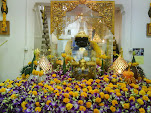 The robes come in different sizes and nowadays are usually made of cotton, silk, nylon or some other man-made fabric, but they are always cut to the same pattern and design. They are actually made from many pieces of cloth sewn together in, according to legend, the pattern of the paddy fields of Magadha in Northern India. They are made in many pieces to recall the days when monks made their own robes from bits of cloth found in charnel grounds. The size and way of wearing the outer robe has changed since the Buddha's time and may vary a little from country to country, but however it is worn, the monk should always look neat and his body should be well covered.
The robes come in different sizes and nowadays are usually made of cotton, silk, nylon or some other man-made fabric, but they are always cut to the same pattern and design. They are actually made from many pieces of cloth sewn together in, according to legend, the pattern of the paddy fields of Magadha in Northern India. They are made in many pieces to recall the days when monks made their own robes from bits of cloth found in charnel grounds. The size and way of wearing the outer robe has changed since the Buddha's time and may vary a little from country to country, but however it is worn, the monk should always look neat and his body should be well covered.In Thailand the jivorn is large and is generally wrapped around the body with the two ends rolled together. This roll is taken over the left shoulder and under the left arm so that its end can be held in the left hand or pressed firmly between the arm and the body. Inside the temple the robe is worn so that the right shoulder is exposed, but outside the temple both shoulders and arms are covered. The colour of the robes varies from monastery to monasteryIn modern times, the monk's wardrobe consists of his outer robe civara (jivorn) and an under-robe antaravassaka (sabong) that is worn around the waist, covering the navel and falling to just below the knees. The sabong is held up by a fold and a tuck and a cord belt. On the top part of his body, under the jivorn, is worn a sort of sleeveless one-shouldered waistcoat (ungsa) which is joined together on the left side by tying tags. For religious services inside the monastery, the monk also wears an additional robe (sanghati) which is folded in a very particular way into a long rectangle and hung over the left shoulder. The monk may or may not wear sandals, depending on the tradition of his particular monastery, though most do. He may carry a soft bag, called a yarm, which is like a shoulder bag but which is carried in the crook of the arm and should never be worn on the shoulder or slung over the back.
胡


No comments:
Post a Comment